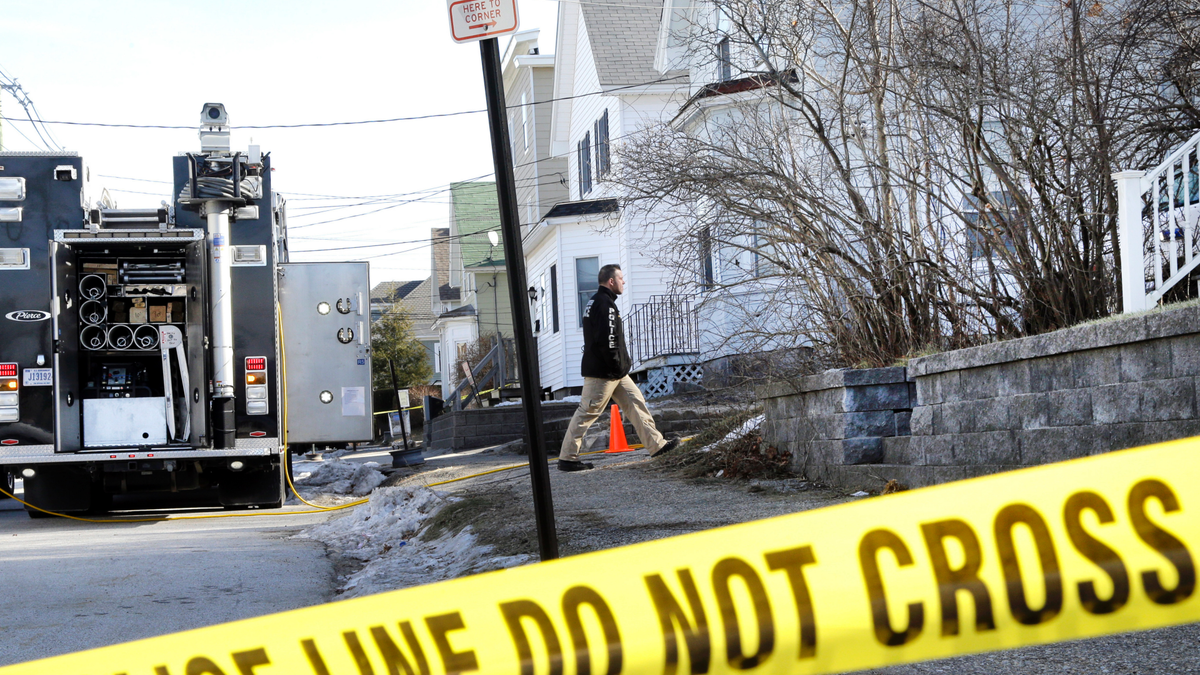
FILE--In this Jan. 17, 2017 file photo, a police officer walks up the driveway of a house in Manchester, N.H. during a search in the case of a woman who once lived there and disappeared more than 35 years ago. New Hampshire authorities have identified three victims of Terry Peder Rasmussen, who is suspected of killing at least six women and children several decades ago, including his toddler daughter. Rasmussen, who used multiple names in many states, died in a California prison in 2010. (AP Photo/Elise Amendola, File)
CONCORD, N.H. – For nearly two decades, four suspected victims of serial killer Terry Peder Rasmussen remained unidentified — only decomposed bodies found in two barrels. But on Thursday, authorities were able to name three of them.
The state attorney general's office confirmed one of the victims was 24-year-old Marlyse Elizabeth Honeychurch. Her two daughters, 6-year-old Marie Elizabeth Vaughn and 1-year-old Sarah Lynn McWaters, also were identified.
The body of another girl found in a barrel hasn't been identified yet and isn't believed to be related to them. Authorities believe Rasmussen is responsible for all four deaths and that the unidentified body is his daughter's. Known as the Allenstown victims, the bodies of a woman and three children were found in two barrels near a state park in Allenstown, New Hampshire, in 1985 and 2000.
Rasmussen, who is suspected of killing at least six women and two children, died in a California prison in 2010. Attempts to reach relatives of Rasmussen have been unsuccessful.
"This restores a level of dignity and respect to those that lost their voice over 33 years ago and certainly gives us an appreciation of who they were and how they lived," said New Hampshire State Police Col. Christopher Wagner, who met with relatives of the victims before the press conference that included family photos of the three .
Several relatives appeared at the press conference but didn't speak publicly.
"The day comes with a heavy hearts," they said in a released statement. "Marlyse, Marie and Sarah were so loved by our families and they are greatly missed. We take solace in finally having the answers we have longed for."
Honeychurch was last seen in 1978 with Rasmussen, who was her boyfriend at the time.
The announcement is the latest twist in the case of Rasmussen, a Navy veteran who went by five different names and moved around most of his life, working on oil rigs, as a mechanic and on other jobs. He went by Bob Evans in New Hampshire and Lawrence Vanner in California, but authorities said that his real name was Terry Peder Rasmussen.
In 1981, Rasmussen was living with girlfriend Denise Beaudin and her 6-month-old daughter, Dawn, in Manchester, New Hampshire. All three disappeared that year, but Beaudin's family never reported her missing, believing the couple left town because of money troubles.
Although her body has not been found, authorities believe Rasmussen killed Beaudin somewhere between New Hampshire and California.
In 1986, Rasmussen abandoned the baby, whom he called Lisa, and fled. He later served about 18 months in jail for child abandonment but took off after being paroled in 1990, authorities said.
In 2003, he was convicted of killing Eunsoon Jun, whom he had married two years earlier in an unofficial ceremony in Richmond, California. Her partially dismembered body was found in their basement, buried under cat litter.
"Together, we have been able to uncover the identity of the Allenstown killer, a murderer who tried erase his victims and hide in the process," Associate Attorney General Jeffery A. Strelzin said. "He tried to hide who he was and what he did but ultimately he wasn't successful. We know what he was. We know what he did and now we know who his victims were."
When they were found inside the barrels in a forest, authorities said the remains of the four were too decomposed to be identified. All they could say was that the four were murdered.
The National Center for Missing and Exploited Children produced facial reconstruction of all four. Authorities then turned to DNA testing, determining that Rasmussen was the father of the unidentified victim, but not related to the other three.
Prospects for identifying the four improved greatly in 2017, when authorities identified the suspected killer as Rasmussen and the case drew renewed attention.
From there, they got help from a librarian from Connecticut who focuses on missing persons and had listened to a podcast about the case on New Hampshire Public Radio . She remembered an earlier posting about the missing Sarah McWaters on an ancestry site and reached out to the person who had posted it. That led to the confirmation that Honeychurch and her children were last seen with Rasmussen at her mother's on Thanksgiving in 1978.
With information linking Rasmussen to the three, New Hampshire authorities turned to her friends and relatives to fill in details of the young woman's life. They were also able to use mitochondrial DNA to confirm a familial relationship and genealogical research to provide a final confirmation of their identities.
Now that the three bodies have been positively identified, Strelzin said the focus will be on identifying the fourth body — possibly by locating the girl's mother if she is still alive. They also are hoping to locate the body of Beaudin, another victim of Rasmussen's killing spree.
"The easy answer is we don't know where she is," Strelzin said. "What we know is that Terry Rasmussen left four victims behind in New Hampshire ... It is possible that Denise Beaudin is in fact somewhere in New Hampshire and we haven't found her. Collectively, we think it's more likely he probably left New Hampshire with her."





















